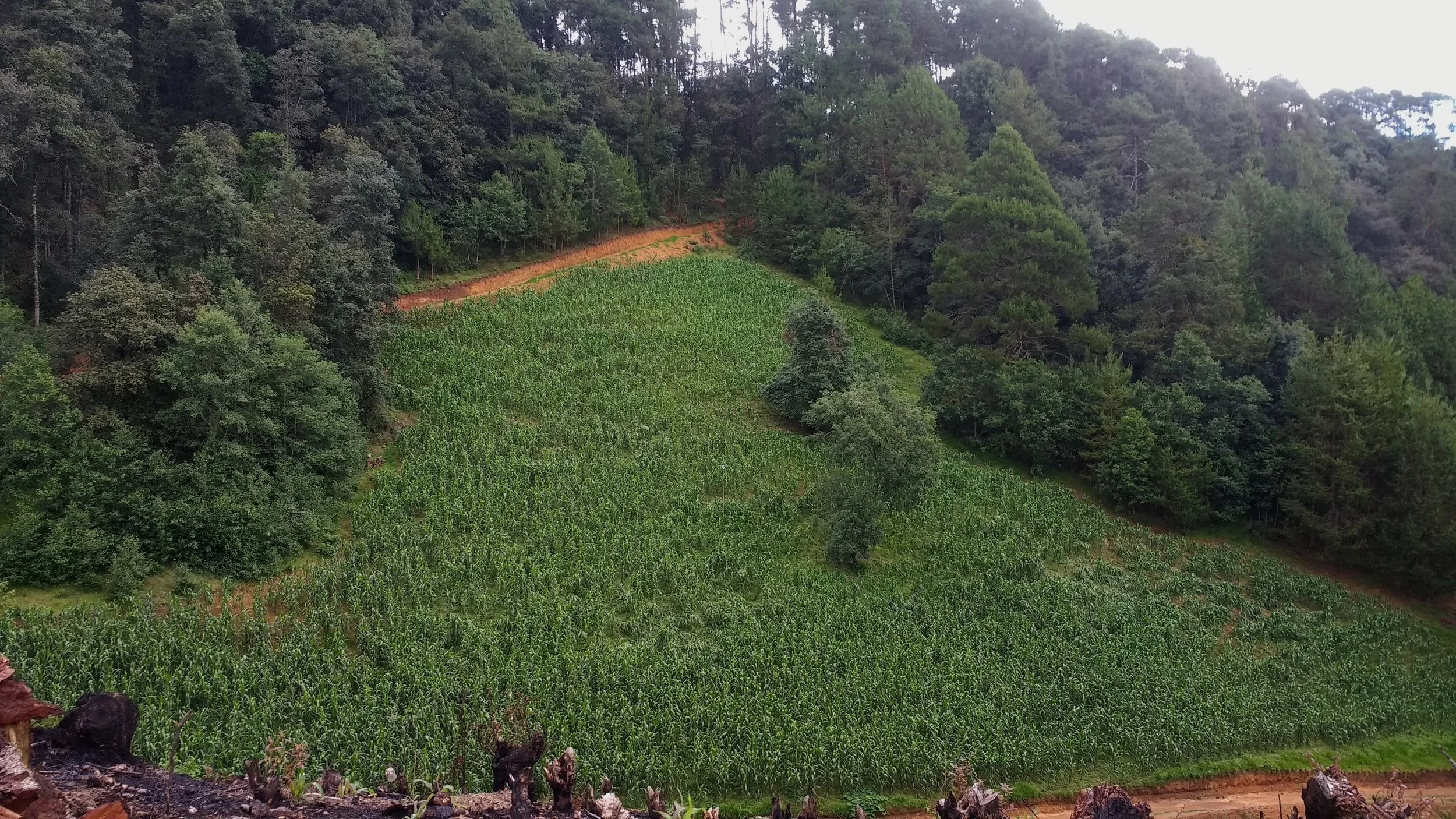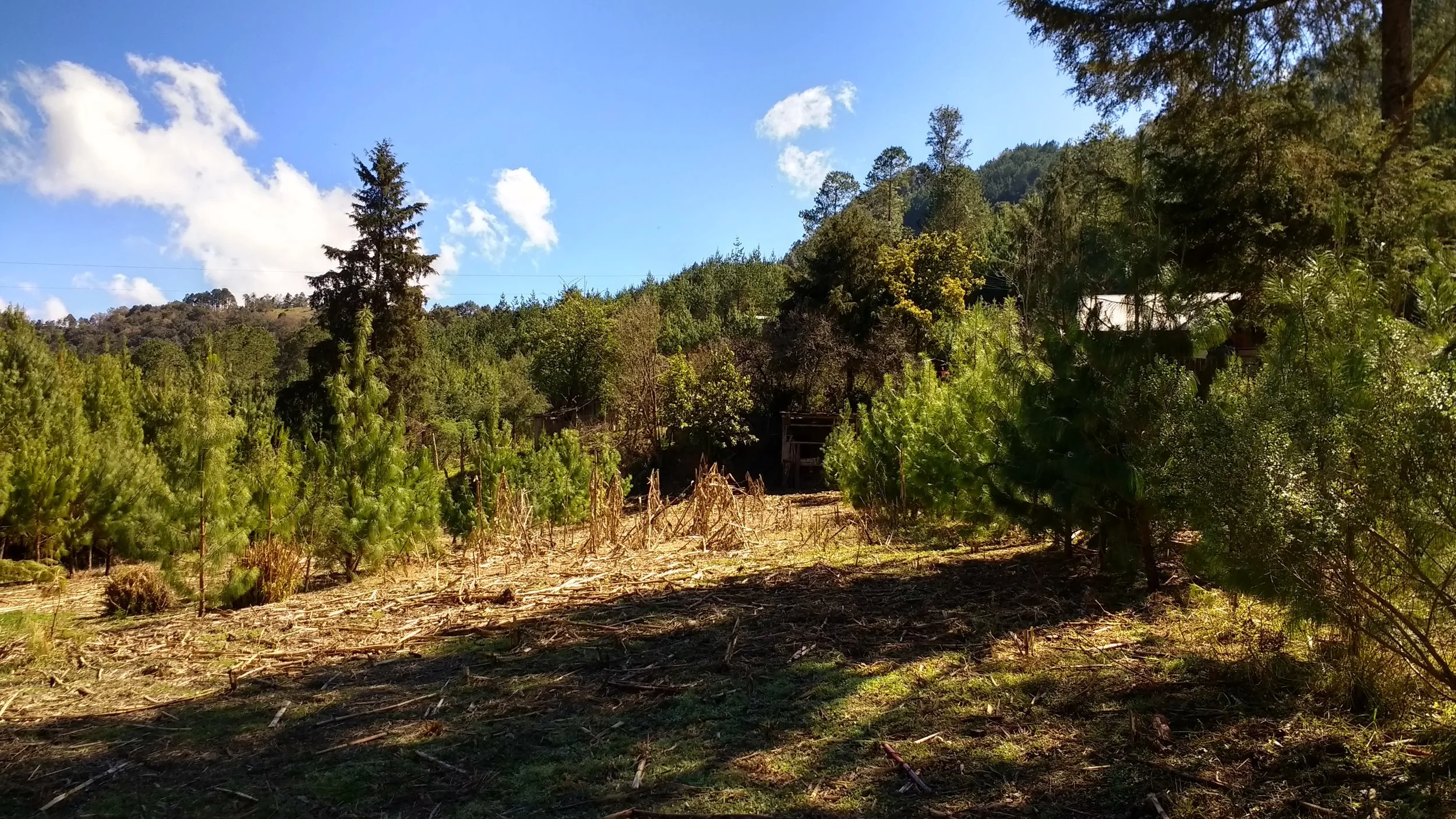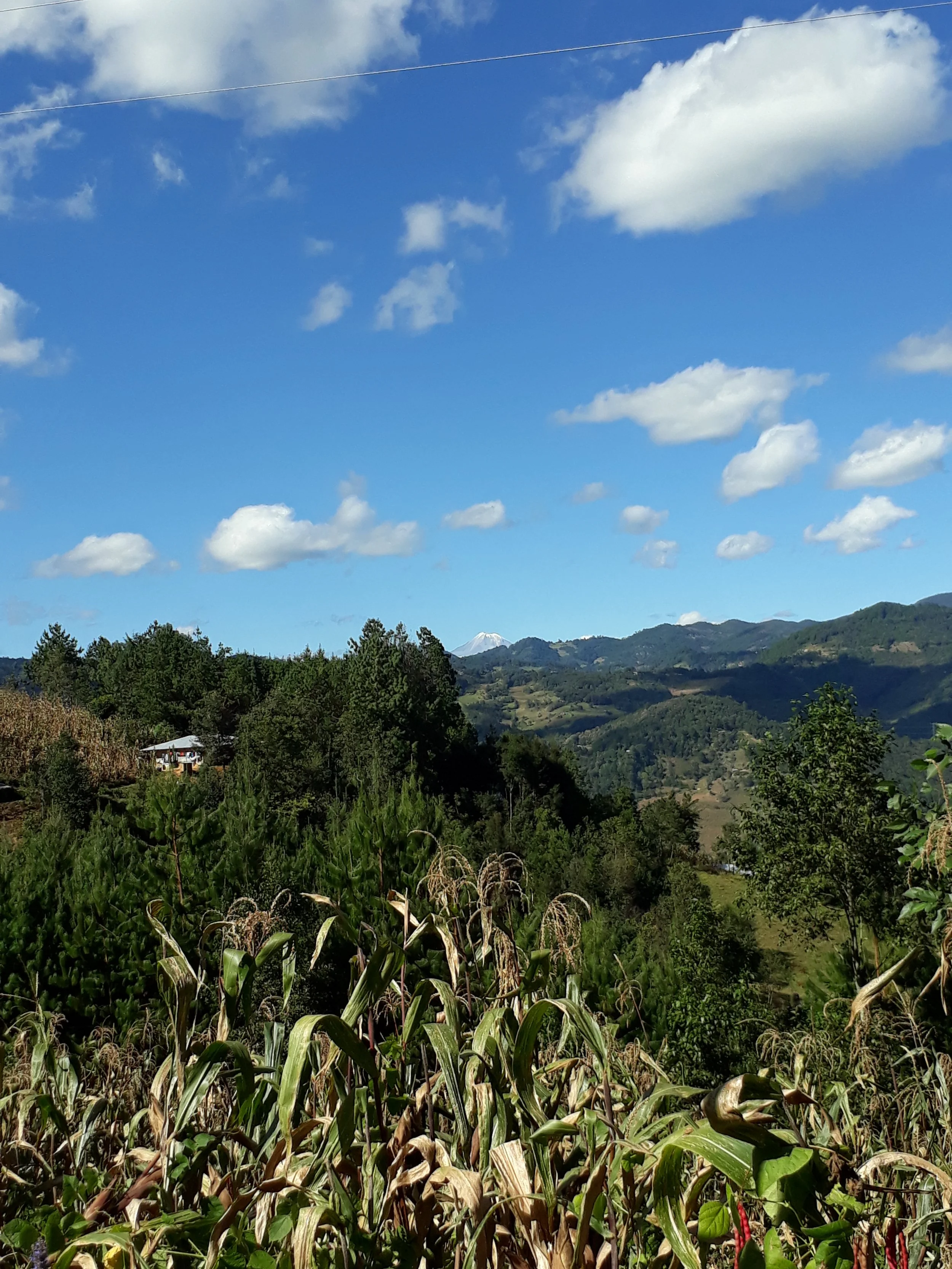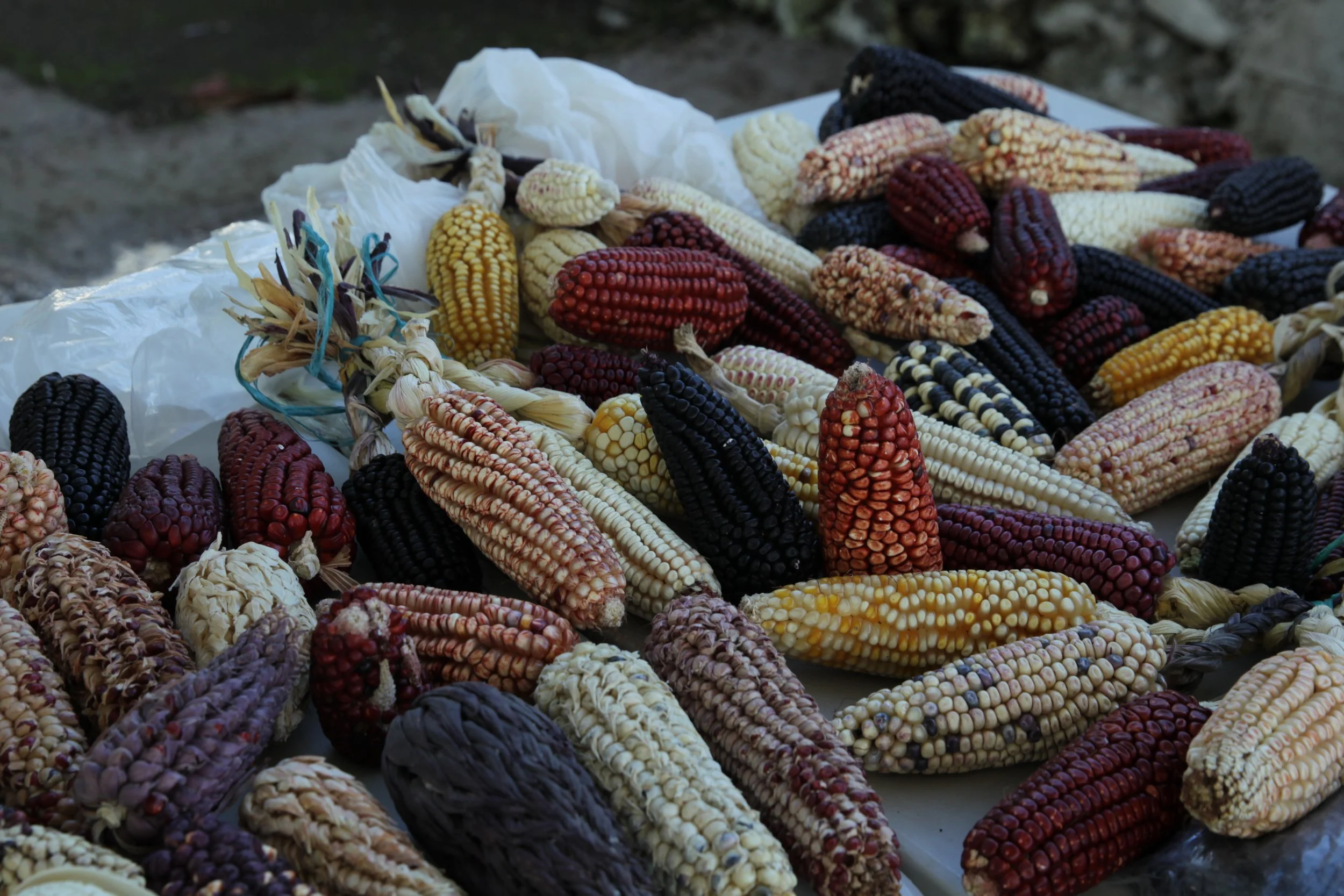Milpa, a diversified food production system
Family-owned milpa in the Sierra de Zongolica. (Photo: Miguel Ángel Vega)
by Citlalli López Binnqüist, Belinda Contreras Jaimes and Fortunata Panzo Panzo
Background
Milpa is a word of Nahua origin that refers to the place where the corn crop in association with other plants is located. It is a polyculture strategy in which corn is combined with different intentionally planted and non-planted (i.e. edible weed) species. The combination is the basis of nutrition for indigenous peasant farmers, mainly produced for self-consumption.
The milpa system is based on traditional ecological knowledge developed in Mesoamerica. The techniques and traditions associated with its cultivation and its consumption for food include the essential corn processing called nixtamalization. The cultivation techniques reflect knowledge at the level of species and ecosystems. Constant experimentation eventually finds the best cultivars for different growing conditions and for different end uses.
Milpa combines diverse species (wild, tolerated, cultivated) of Mesoamerican origin as well as other introduced species. Among these are: corn (Zea mays l.), beans (Phaseolus vulgaris l., P. coccineus L., Cajanus cajan) millsp, (Vigna umbellata Ohwi and Ohashi), coffee (Coffea arabica L., C. canephora Pierre ex Foehner), squash (Cucurbita moschata Duch ex Poir. C. mixta Pang. C. ficifolia Bouché), faba bean (Vicia faba l.), peas (Pisum sativum l.), barley (Hordeum vulgare l.), oats (Avena sativa L.), potato (Solanum tuberosum L.) and banana (Musa spp).
Family-owned milpa in the Sierra de Zongolica. (Photo: Miguel Ángel Vega)
Milpas in the Sierra de Zongolica
This case study is based on the milpas of the Sierra de Zongolica, Nahua territory in the center of the state of Veracruz, Mexico, inhabited since pre-Hispanic times. The Sierra de Zongolica constitutes the southern end of the Sierra Madre Oriental Mountain range. Geologically, it is in a karst zone, with very steep slopes, boxed-in valleys and closed depressions with no apparent external runoff. Due to its rugged orography with altitudes ranging from 500 to 3,000 meters above sea level, it is divided into two main zones, the cold zone and the warm zone.
A great adaptability is observed in the milpa cultivation due to the diversity of social-domestic conditions and the environmental heterogeneity of the Sierra de Zongolica. Depending on the terrain, slopes, soil types and soil depth, specific tools are used – so for example a plow can only work in mostly level areas. Maize and other crops grow more slowly in colder areas and so must be planted and harvested on a schedule that varies considerably depending on the altitude (and many other factors) (López Binnqüist et al., 2017; Rodríguez, López and Alvarez, 1992).
Family-owned milpa in the Sierra de Zongolica. (Photo: Gabriela Alvarez)
Dzib (1994) at the beginning of the nineties identified that maize has a wide diversity in the mountains depending on the type of milpa, if it is done with a plow or slash-burn, on what type of terrain, and types of hillsides, elevation zone (warm, cold) as well as the different sowing seasons. In his study Dzib (1994) reports the identification of eight races, a sub-race and a maize variant in the Zongolica mountains.
Regarding beans planted in the mountains, Araujo and Baéz (1994) identified three genera, four species and four variants of beans. Araujo et al (1993) report the importance and diversity of native beans, in three contrasting ecological and social conditions of the Sierra de Zongolica. Likewise, Araujo and Báez (1994) reported more than fifteen different dishes prepared with different parts of the bean, mainly seed, in different phenological stages and conservation status.
The milpa as a farming system has been an essential part of life of campesino families for thousands of years. This has been an inspiration for writers like Armando Bartra: "Mesoamericans do not plant corn, Mesoamericans plant milpa and those are two different things, because corn is a plant and the milpa is a way of life" (2014).
At the heart of the milpa and the Nahua worldview is the concept of "reciprocity." Reciprocity is the axis that combines the relationships between the individual, society and the environment as a way of maintaining family ties and maintaining networks within and between communities.
The exchange (barter) prevails over the sale. A common denominator that characterizes the milpa in Mexico, including the Sierra de Zongolica, is the free exchange of germplasm in the immediate environment of peasant families and outside their communities.
For the Nahuas, the possession of the land entails a deep meaning that is embodied in the action of cultivating it, harvesting it and consuming the products of the milpa. Even when the land and the milpa have lost their original significance as a source of resources for survival, due to the scarce agricultural vocation of the soils and other factors such as the lack of supports to the labor, for the Nahuas of Zongolica the sacred character of the land remains (Báez-Jorge, 2000).
The earth and the corn make up a unit in ritual terms and are part of a set of both operational and symbolic meanings. The corn harvest also allows families to participate in community festivals by preparing food and offering ceremonial banquets. In the festivities of Todos Santos, for example, at the beginning of November, tamales, atoles and sweets are prepared in the kitchens to place them in the offering to the Fieles Difuntos and to exchange them with compadres, relatives and neighbors. The same goes for mayordomía parties and life cycle rituals, for which large quantities of tortillas and other dishes are prepared.
Products from the milpa. (Photo: Gabriela Alvarez)
Variety of native corn from the Sierra de Zongolica. (Photo: Gabriela Alvarez)
Since milpa is a complex and diverse system, it faces different conservation status throughout the country. Some of the traditionally harvested species are in threat while others are not of concern. Loss of knowledge, climate change and changes in soil uses are factors that impact milpa. Yet tradition is being amalgamated with local adaptations that are responding to changing conditions. The variety of adaptations are as diverse as the heterogeneity of the towns and contexts that practice milpa planting. These peasant trial and error experiences are turning out, in short, to be the most promising resilience strategy for all that constitutes the milpa system.
Martínez Esponda (2018:12) states that “…through the milpa, important human rights of indigenous peoples and peasant communities are expressed and exercised, such as: (1) the right to cultural identity, (2) the right to territory and traditionally managed natural resources, (3) the right to adequate food, (4) the right to health and (5) the right to a healthy environment”. However, in Mexico there is still no legal support that protects and promotes the milpa.
References
Araujo Rodríguez, C. & Baez Vázquez, J.E. 1994. Colecta y caracterización preliminar de cultivares de frijol en la sierra de Zongolica, Ver. Sexta Reunión Científica del Sector Agropecuario y Forestal del Estado de Veracruz, Veracruz, Mexico.
Báez-Jorge, F. 2000. Los Oficios de las Diosas, Dialéctica de la religiosidad popular en los grupos indios de México. Universidad Veracruzana, Veracruz, Mexico.
Bartra, A. 2014. “Por un cambio de paradigmas”. En Bartra, A. Cobo, R., Meza, M., Paredes, L., Quintana, V. y Rudiño, L. Haciendo milpa. Editorial Itaca, Mexico.
Dzib Aguilar, L.A. 1994. La tecnología de cultivo en la sierra de Zongolica, Ver. Revista de Geografia Agrícola 20.
López Binnqüist, C., Hidalgo Ledesma, R. & Panzo Panzo, F. 2017. “Keeping our milpa: maize production and management of trees by Nahuas of the Sierra de Zongolica, Mexico”. In Sillitoe, P. (editor) Indigenous knowledge: Enhancing its contribution to natural resources management. CABI Publishers. UK. pp.40-50.
Martínez Esponda, X. 2018. Derechos Humanos y Patrimonio Biocultural. El Sistema Milpa como cimiento de una política de Estado cultural y ambientalmente sustentable. Centro Mexicano de Derecho Ambiental, CEMDA. Available here.
Rodríguez, López, M.T. & Alvarez, S. 1992. “Estrategias productivas de entre los nahuas de Zongolica” La Palabra y el Hombre 84, 127–144.





